Golfing Stretches
Golfing
stretches should be part of any training program. The mechanics of the
golf swing require flexibility, coordination, strength and stability.
Golfers with poor mobility will suffer in terms of generating club head
speed and will likely develop compensatory adjustments to their swing
that will lead to inaccuracy and injury.
Why
do we
need to
do golf stretches?
What type of stretching is best for golf performance?
Test for Spinal Flexibility.
Golfing stretches.
What shoulder muscles are used most in the golf swing?
Physics and the golf swing.

Why do we need to do golfing stretches?
Golf is an activity that requires strength, flexibility, coordination,
and to a lesser extent muscular and cardiovascular endurance. Golfers
with limited range of motion will be severely affected in their ability
to generate club speed. Loss of range of motion is probably
more
important than loss of stretngth in affecting club speed in an aging
golfer. Loss of spinal rotation, hip rotation, and shoulder range of
motion affect how far back the club will start and the length of follow
through.
Power is
dependent on the velocity of your swing as it hits the ball. The
range of motion in your trunk directly correlates to the ability to
generate club head speed. The
golf club has a limited amount of time to accelerate during your down
swing to achieve its maximum velocity at contact. By improving your
flexibility, the degree of trunk rotation relative to your hips, hence,
the distance of the upswing, you likewise increase the
distance that the club has a chance to accelerate prior to contact with
the ball.
Golfing Stretches - What Type of Stretching is Best for Golf Performance?
A study published in the International Journal of Sports
Medicine in
2009 (1) examined the effects of static, dynamic, and no stretching on
golf performance after their inclusion in part of a warm up. While
there are many determinants of golf performance, golf performance in
this study was measured as club head speed, ball speed, swing
path, point of impact on the club head, and club face angle.
Measurements of club head speed were taken immediately after
stretching, five minutes after stretching. 15 minutes after stretching,
and 30 minutes after stretching.
Result were as follows:
- Dynamic golfing stretches produced significantly greater club head speeds than static stretching and no stretching. This effect was present even 30 miniutes post-stretch.
- Dynamic golfing stretches produced significanly greater ball speeds than static stretching and no stretching. This effect was present even 30 miniutes post-stretch.
- Dynamic golfing stretches produced significantly straighter swing paths that static stretching and no stretching. This effect was present even 30 miniutes post-stretch.
- Dynamic golfing stretches produced impact points on the club face that were more centred that static stretching or no stretching. This effect was present even 30 miniutes post-stretch.
- The club face angle was not affected by stretching.
- There was no significant difference in club head speed between those that performed static stretches and no stretches.
- There was no significant difference in ball speed between those that performed static stretches and no stretches.
- There was no significant difference in swing path between those that performed static stretches and no stretches.
- There was no significant difference in the impact point on the club head between those that performed static stretches and no stretches.
Recommendations based on this study suggest a good dynamic warmup is in order prior to a golf game to improve performance.
Test for Spinal Flexibility.
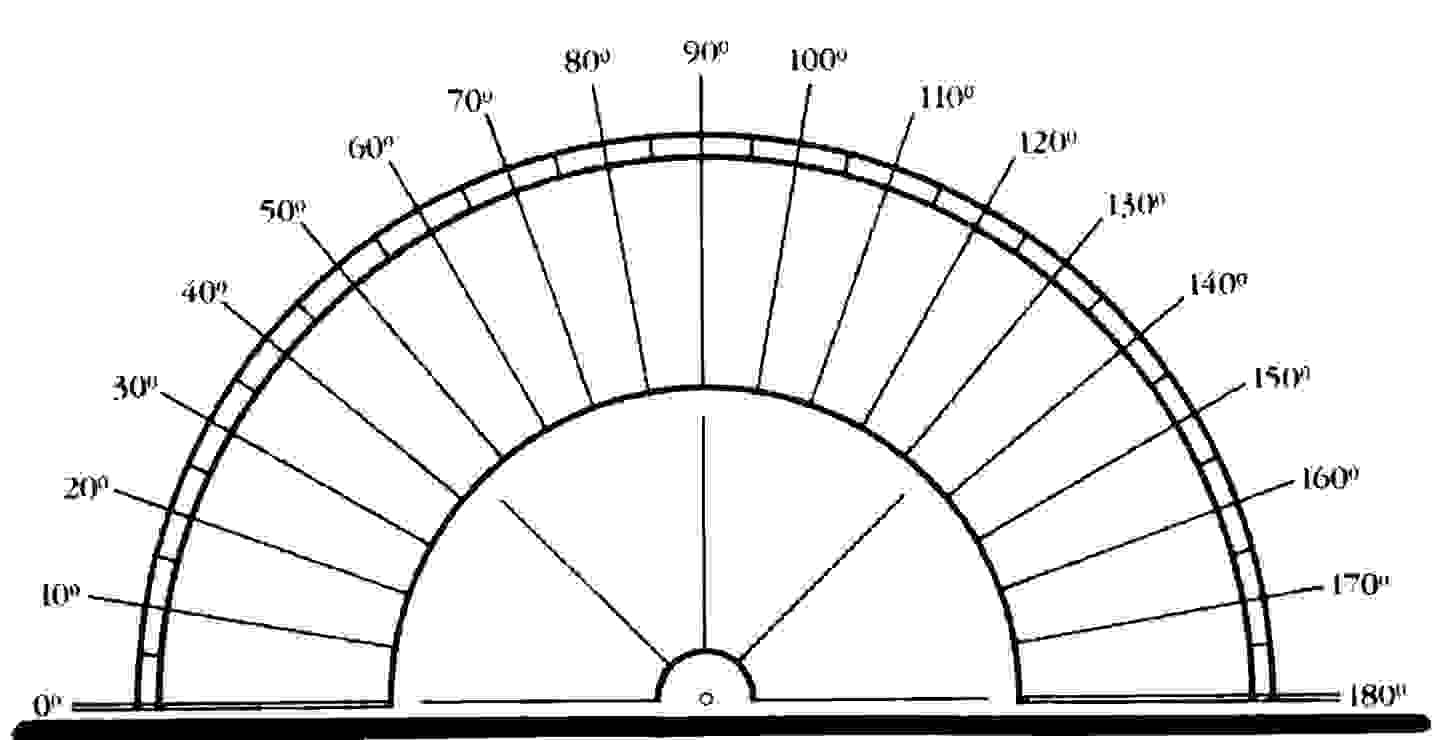
One of the most important factors in determining clubhead speed is the
ability to rotate the trunk during the backswing. People who have lost
this due to age, injury, smoking, etc. will undoubtedly experience a
drop in distance of their shots. Golfing stretches should be done
regularly to increase and maintain mobility.
- Print the following protractor.
- Stand with your feet shoulder width apart with the protractor on the floor at your feetso that the thick black line runs between your big toes.
- Grip a driver with your one hand on the handle, and the other on th club head.
- Put the shaft over your head so that it rests lengthwise across your shoulders.
- Your driver should now be parallel with the thick line of the protractor.
- Slowly turn your trunk as you would during a backswing while keeping your feet firmly planted on the ground.
Golfing stretches.
Golfing Stretches: Flexion in lying
Lumbar
flexion in lying
stretches the
following structures:
- Erector Spinae
- Transversospinalis
- Supraspinous and Intraspinous ligaments
- Ligamentum flavum
- Posterior Longitudinal ligament
- Facet joint capsule
- Posterior elements of the disc
- Fascia
- Lie on your back.
- Bend your knees up so that your feet are flat on your floor.
- Grab hold of both your knees and slowly pull them up toward your chest. If you have discomfort in your knees doing this you may grab the back of your thighs. If your abdomen gets in the way then spread your legs apart and pull up. Keep your neck and shoulders relaxed during this stretch and breath normally.
- Hold this for a period of 30 seconds.
You should pull only to the point of tension. You should not pull into
any pain, bounce, or force the movement.
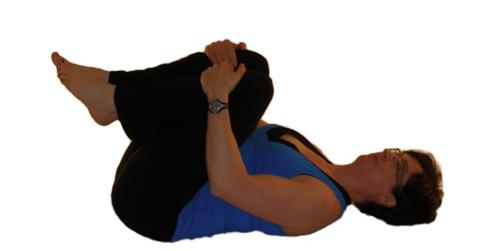
Golfing Stretches: Trunk Extension in Lying
- Lie on the floor or your bed face down.
- Put your hands at your sides at shoulder level like you are going to do a push up.
- Whilst keeping your back relaxed and hips on the floor, push your shoulders up and straighten your arms.
- Exhale when you reach the top and let your mid back sag as you exhale.
- Slowly lower yourself to the starting position.
- Do not hold this position, but simply repeat the up and down motion 10 times.
You should push only to the point of tension while maintaining your
hips on the floor. You should not push into any pain, bounce, or force
the movement. You should have a gentle curve in your back as you push
up, no severe curvatures in one location.
Do not do this exercise if you have been advised by your
physical
therapist not to. If you have any pain or create new pains by doing
this exercise consult your physical therapist.
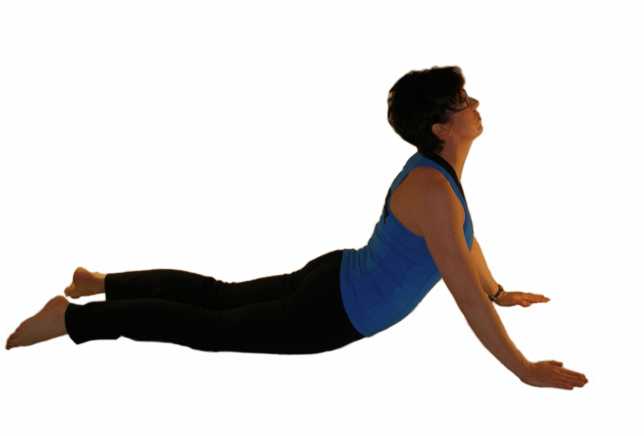
Golfing Stretches: Hamstring Stretch
This is an effective
hamstring stretch sitting on the ground, but depends on pelvic
positioning. If you are
able to maintain a straight lower back and anteriorly tilted pelvis
while performing this stretch it
is significantly more effective.
- To perform this stretch sit on the ground with your right leg stretched out in front of you and your left knee bent with foot facing your right knee.
- Keep your chest up and back straight.
- Bend forward at the hips until you feel a stretch in the back of your thigh.
- Hold this position for 30 seconds. For a discussion on how long you should hold a stretch see here.

Golfing Stretches: Short Adductor Stretch
- Sitt on the floor with your knees apart and the bottom of your feet together.
- Keep your chest up and your back straight.
- Bend forward at the hips while accentuating your lumbar lordosis (keep pelvis tilted anteriorly)
- Apply gentle pressure to your knees pushing them toward the floor.
- Relax and hold this for the appropriate time.
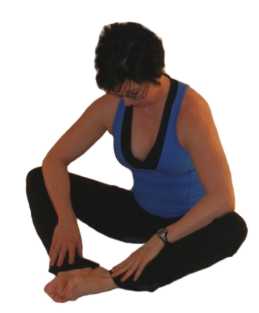
Golfing Stretches: Hip Flexor Stretch
- Kneel on your right knee and put your left foot in front of you.
- If you find this uncomfortable on your knee you can put a cushion or rolled towell under your knee.
- Put your hand on your right hip
- Lean forward and push your right hip forward. You should feel this stretch in the front of your right hip.
- Hold this position for 30 seconds and then perform this stretch on the other side.

Golfing Stretches: Hip Rotators
The hip rotators not only rotate the thigh on the pelvis but more
functionally rotate the pelvis on the weight bearing fixed thighs such
as with swinging a golf club.
- To stretch the right side in sitting cross your right leg over the left so that your right ankle is laying across your left thigh.
- Put your right hand on your right thigh and gently press down until you feel resistance.
- Then tilt forward at the hips slowly as you exhale. Remember to keep your chest up and your back straight. Don't allow yourself to hunch forward or lose the normal lordosis (inward curvature) in your lower back.
- Hold this position for the appropriate time. For most individuals 30 seconds is beneficial.

Golfing Stretches: Sideflexion
- Stand with your chest lifted up and feet shoulder width apart.
- To stretch the right side, bring your right elbow overhead
- Flex your trunk to the left side while pulling your elbow to the left
- Hold this stretch for the appropriate time (20 seconds to 60 seconds depending on age)
- Be sure that you don't rotate your trunk while you are performing the stretch.
- Repeat this for the left side as well.
This stretches a number of muscles and tissues on the right
side:
- Triceps
- Latissimus dorsi
- Levator scapula
- Quadratus lumborum
- Intercostals
- Lower fibres of trapezius
- Also stretches fascia, interspinous ligaments, and shoulder and acromioclavicular joint capsules

Golfing Stretches: Hand Behind Back Club Stretch
The supraspinatus abducts and
externally rotates the shoulder therefore
stretching must involve adduction and internal rotation.
- Put your club behind you
- Grab the golf club behind your back with your right hand
- Pull the golf club with the other hand from above while keeping your right shoulder relaxed and your hand over on the left side of your back
Most people will benefit from holding this stretch for 30 seconds.

Golfing Stretches: Shoulder Horizontal Adduction
- Sit upright on a chair with your chest up and head over your shoulders.
- Raise your right elbow up to shoulder level in front of you.
- Let your right hand fall toward the floor, palm down.
- Grasp your right elbow with your left hand and pull your elbow over toward the opposite side.
- Exhale as you gently pull the arm across and make sure the elbow doesn't rise above shoulder level.
- Hold this stretch for30 seconds.
A tight posterior joint capsule can restrict shoulder movement and
cause impingement of subacromial structures such as the supraspinatus
tendon, biceps tendon, and bursa resulting in tendonitis or bursitis.
This stretch should not cause pain. If you suffer from any of the above
conditions or have pain during this stretch be sure to consult a
physical therapist.

Golfing Stretches: Shoulder Doorway Stretch
Because the fibres of this muscle lie in different directions, it is best to hit it from different angles.
- Stand in a doorway with shoulders and elbows at 90 degrees, hands clasping the door frame to stretch the horizontal fibres and those originating from the clavicle
- Take a step in through the door and hold this
- Raise your hands further up the door frame to hit the lower sternal fibres and that part of the muscle that originates lower on the chest
- Hold this for 30 seconds.
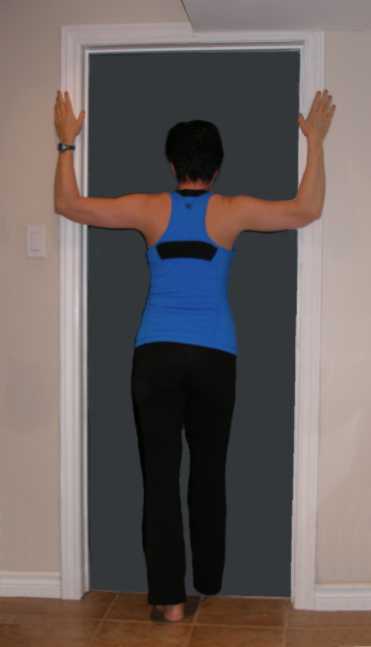
Golfing Stretches: Iliotibial band
This iliotibial band stretch will address tightness in the iliotibial
band on the right hand side. To do this stretch you must be able to
comfortably sit on the floor and already have good hip mobility.
- Sit with your legs crossed, right leg on top .
- Slide the top leg across so that your knees are touching or try and get them as close as you can.
- Bring your feet forward in front of your knees. (If you feel any strain in your knees or pain in your groin then stop the stretch and straighten your knees. You may have an underlying hip or knee problem and should seek the advice of a physical therapist.)
- Keep your back straight and bend your trunk toward the right foot.
- Hold this position for 30 seconds, relax and breath.

Golfing Stretches: Calf Stretches
Because part of the calf originates from above the knee, and part originates below the knee, stretching involves two parts.
- Stand about three feet from a a wall and put your right foot behind you ensuring your toes are facing forward
- Keep your heel on the ground and lean forward with your right knee straight
- Rotating the toes in
and out slightly will target the medial and lateral parts of this
muscle separately
- Hold this
- Bend the right knee and keeping your heel on the ground hold again to target the soleus.
- Hold this position for 30 seconds.
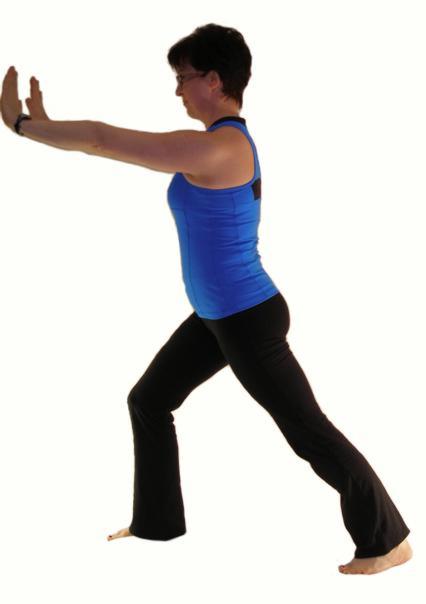
Golfing Stretches: Wrist Flexor Stretch
- Standing or sitting, straighten your right arm out in front of you with your elbow straight with palm facing up.
- Grasp your right hand above your knuckles, and below your wrist and pull your hand down.
- You should feel a stretch in the flexor muscle group on the front of your forearm.
- Hold this stretch for 30 seconds.
Tightness in the wrist flexors can predispose you to golfer's elbow
(medial epicondylitis). Repetitive use of these muscles in activities
such as gripping, tennis, golf, or assembly line work can cause
microtearing and inflammation. This is a good stretch to do on a daily
basis if you are involved in any of the above activities. This stretch
should not ellicit pain. If you have pain during this stretch you may
already have issues with the muscle or tendon(s) and you should seek
the advise of a physical therapist.

Golfing Stretches: Wrist Extensor Stretch
- Sitting or standing, straighten your right arm out in front of you with your elbow straight with palm facing down.
- Grasp your right hand above your knuckles and pull your hand down.
- While your hand is down and elbow straight, pull your hand out away from midline so that your fingers are pointing to the right.
- Remember "down and out"
- Hold this stretch for 30 seconds.
Tightness in wrist extensors, particularly extensor carpi radialis
brevis, can predispose you to tennis elbow. Repetitive use of these
muscles in activities such as typing, tennis, golf, or assembly line
work can cause microtearing and inflammation. This is a good stretch to
do on a daily basis if you are involved in any of the above activities.
This stretch should not ellicit pain. If you have pain during this
stretch you may already have issues with the muscle or tendon(s) and
you should seek the advise of a physical therapist.

Golfing Stretches: Neck Flexion
- Stand tall with your chest up and head high.
- Put one hand on your chin and retract your head (so that you have a double chin)
- Keep your head upright, don't look up or down. Keep eyes facing forward.
- While holding your chin back, use your other hand to reach over the top of your head.
- Stabilize your chin back as you gently pull the top of your head forward.
- Hold this stretch for about 30 seconds (see information on the appropriate time)
This is not a large movement so don't force this stretch. Be sure to
keep your chin retracted during this stretch to avoid shearing forces
on the joints in your cervical spine. You want to stretch the muscles
and other soft tissues on the posterior aspect of your neck, not stress
the discs. If you have any discomfort during this stretch you may be
doing it wrong or have underlying problems. Consult a physical
therapist.

Golfing Stretches: Neck Sideflexion
- Stand tall with your chest up and head high
- Put your left hand up over your shoulder and bring your elbow back, pointing your left elbow up to the ceiling
- Use your right hand to gently pull your head forward and to the right
- Hold this position for about 30 seconds
Be gentle with this stretch. Older individuals will have significantly
less range in this direction.

Golfing Stretches: Trunk Rotation
This
one is an easy one to do in standing although you can also do it in
sitting. The golf swing involves significant trunk rotation a lot of
which occurs through your thoracic spine and neck.
- Hook your arms around the golf club placed lengthwise across your back.
- Rotate your trunk and head to the left and hold it there for 20 to 30 seconds.
- Don't swing and bounce into this stretch as that will put undue strain on the joints and ligaments of your spine.
- Repeat this on the other side.
If you perform this stretch in sitting you will reduce the amount of stretch you get in the lower lumbar region.
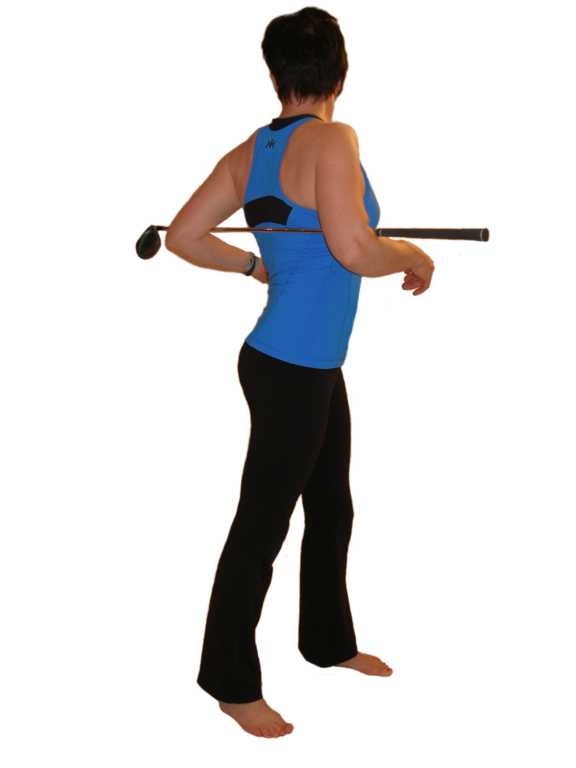
Golfing Stretches: Latissimus Dorsi
- Stand approximately 3 feet from a wall
- Place both hands on the wall one on top of the other as high as you can reach.
- Step back with one foot.
- Bend at the hips, keeping your chest up and chin tucked in.
- Take a deep breath, exhale slowly and let your back sag toward the floor while maintaining your hands high above your head on the wall.
- Hold this for 30 seconds.
Electromyographic studies have shown that the
latissimus dorsi along
with the pec major provide significant power to the golf
swing.(2)

Quadricep Stretch
- Stand beside your cart or a wall so as to hold on with one hand if necessary to balance.
- Grab your ankle behind you. You can use the hand on the same side or the opposite side. Most people find using the opposite hand most comfortable because it allows the hip to stay in a comfortable position.
- Straighten your back, lift your chest up and pull your ankle back and up slowly.
- If you are able to bring your knee behind you as in the picture you can stretch rectus femoris as well.
- Hold this position for 30 seconds and then perform this stretch on the other leg.

What shoulder muscles are used in the golf swing?
A study published in the American Journal of Sports Medicine in 1986
used electromyography and high speed photography to identify muscle
firing patterns during the golf swing.(2)
Electromyographic studies have shown that the latissimus
dorsi along
with the pec major provide significant power to the golf swing.
Seven healthy right handed male golfers used to study activity in the
following shoulder muscles: supraspinatus, infraspinatus,
subscapularis, latissimus dorsi, anterior posterior and middle deltoid,
and pectoralis major. Activity of these muscles in the right shoulder
were then compared to the left shoulder during a right handed swing.
Results showed that the deltoid was relatively inactive on both sides
and supraspinatus and infraspinatus fired at low level
throughout the
swing. The subscapularis was very active thoughout the swing, and the
lat dorsi and pec major appeared to provide most of the power on both
sides with most activity occuring with the downswing.
Contrary to popular belief, the rotator cuff muscles on the
left showed just as much activity as those on the right.
Fun Physics facts and the golf swing.
Distance in yards
Degrees in Celcius
224
35
222
29
220
24
216
18
214
13
Wind speed (km/h)
Length (yards)
into wind 48
162
into wind 24
208
no wind
232
with wind 24
255
with wind 48
268
- Transfer of momentum from the clubhead to the
ball is
achieved most efficiently when the ball is hit at the "sweet spot" (ie
centre of mass). A hit that is as little as one centimeter off of the
centre of the club face will make a difference of about 15 yards.
1. K. A. Moran, T. McGrath, B. M. Marshall, E. S. Wallace
Dynamic Stretching and Golf Swing Performance. Int J Sports
Med
2009;30(2): 113-118
2. FW Jobe, MD, DR Moynes, MS, RPT, DJ Antonelli, PhD. Rotator cuff
function during a golf swing. Am J Sports Med September 1986 vol. 14
no. 5 388-392 .